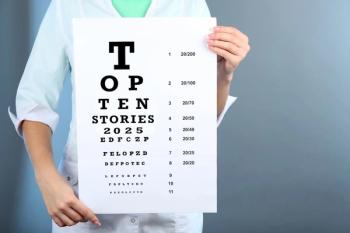
- Ophthalmology Times: July/August 2025
- Volume 50
- Issue 4
Study establishes reference data set for geographic atrophy lesion progression
Key Takeaways
- Lesion characteristics, such as fovea-sparing, multifocal, and bilateral lesions, significantly influence GA growth rates in AMD.
- The study involved 204 eyes from 111 patients, providing a comprehensive dataset on GA growth dynamics.
Fovea-sparing, multifocal, and bilateral lesions exhibited the fastest growth rates.
The lesion characteristics of patients with geographic atrophy (GA) were found to affect the lesion growth rate, with fovea-sparing, multifocal, and bilateral lesions having the fastest growth rates in a study published in Translational Vision Science & Technology.1
Daniel R. Muth, MD, the first author of the study, and colleagues evaluated the long-term fundus autofluorescence–based growth rate of lesions in treatment-naive patients with GA. The authors conducted the study to observe the GA progression and establish a comprehensive data set on the long-term growth dynamics of GA as a reference for future preclinical treatment developments and clinical trial end points.
Muth practices in the Division of Eye and Vision, Department of Clinical Neuroscience, Karolinska Institutet, Stockholm, Sweden; St Erik Eye Hospital, Solna, Sweden; and the Department of Ophthalmology, University Hospital of Zurich, University of Zurich, Switzerland.
Approximately 6 million individuals worldwide are estimated to have late-stage dry age-related macular degeneration (AMD) with GA.2 The FDA has approved 2 complement system inhibitors— C3 inhibitor pegcetacoplan (Syfovre; Apellis Pharmaceuticals, Inc) and C5 inhibitor avacincaptad pegol (Izervay; Astellas Pharma Inc)—that have successfully slowed the progression of GA. However, neither of those treatments can improve vision.3-5 In Europe, however, the clinical benefit of pegcetacoplan was considered inadequate by the European Medicines Agency, which resulted in the rescinding of its market approval.6 The manufacturer of avacincaptad pegol then withdrew the drug from the application process.7“This development highlighted the need for European long-term data on GA kinetics and new biomarkers,” Muth and colleagues stated.
The bottom line is that AMD still lacks sufficient treatment. GA growth kinetics are essential for understanding this disease’s pathophysiology and predicting individual future growth.
GA study design and findings
The authors then conducted the study under discussion, a prospective, single-center, observational study between February 2013 and September 2024 at Karolinska Institutet and St Erik Eye Hospital. The patients underwent a clinical examination, fundus autofluorescence, and optical coherence tomography. The authors recounted that the area and the absolute and square root transformed growth rates were analyzed every 6 months.
Ultimately, 204 eyes of 111 patients (median baseline age, 79 years; range, 56-93 years; 60% women) were enrolled in the study. The median follow-up time was 21 months (minimum-maximum, 5-123). Of 73 eyes in which the fovea was spared, 22 eyes later converted to involvement of the fovea over a median of 24 months.
“The mean growth for the total cohort was 1.597 mm2/year and 0.264 mm/year after square root transformation. Bilateral [1.621 mm2/year; 0.267 mm/year], multifocal [1.961 mm2/year; 0.322 mm/year], and fovea-sparing [1.987 mm2/year; 0.234 mm/year] lesions showed significantly faster growth when analyzed in isolation. In a mixed statistical model that controlled for bilaterality, only foveal status remained a significant influencer on the square root transformed growth rate [P < .001],” the authors reported.
This study indicated that by analyzing the data of one of the most extensive GA patient cohorts in the Nordic countries, it established a data set on the long-term treatment-naive GA growth dynamics. Muth and colleagues pointed out that it provides a reference for upcoming preclinical treatment developments and clinical trial endpoints.
“In this GA cohort, we demonstrated the influence of lesion characteristics on growth rates with follow-up times of up to more than 10 years. Evaluated individually, fovea-sparing, multifocal lesion configuration, and bilateral lesions showed significantly faster GA growth. In combined statistical models, sparing of the fovea remained a significant risk factor for faster growth that was corrected for baseline lesion size by square root transformation. Patients presenting with 1 or more of these lesion characteristics hold a high potential to benefit from future treatments because the slowing of lesion growth may be more likely to be achieved. In fovea-sparing cases, functional preservation may be possible,” they concluded.
Daniel R. Muth, MD
E: [email protected]
Muth practices in the Division of Eye and Vision, Department of Clinical Neuroscience, Karolinska Institutet, Stockholm, Sweden; St Erik Eye Hospital, Solna, Sweden; and the Department of Ophthalmology, University Hospital Zurich, University of Zurich, Switzerland. He is supported by Stiftung OPOS, St Gallen, Switzerland.
References
Muth DR, Quérat L, Venkataraman AP, et al. Long-term natural history of treatment-naïve geographic atrophy in age-related macular degeneration. Transl Vis Sci Technol. 2025;14(5):5. doi:10.1167/tvst.14.5.5
Shen LL, Sun M, Grossetta Nardini HK, Del Priore LV. Progression of unifocal versus multifocal geographic atrophy in age-related macular degeneration: a systematic review and meta-analysis. Ophthalmol Retina. 2020;4(9):899-910. doi:10.1016/j.oret.2020.03.020
Heier JS, Lad EM, Holz FG, et al. Pegcetacoplan for the treatment of geographic atrophy secondary to age-related macular degeneration (OAKS and DERBY): two multicentre, randomised, double-masked, sham-controlled, phase 3 trials. Lancet. 2023;402(10411):1434-1448. doi:10.1016/S0140-6736(23)01520-9
A phase 3 safety and efficacy study of intravitreal administration of Zimura (complement C5 inhibitor). ClinicalTrials.gov. Updated December 12, 2024. Accessed July 10, 2025.
https://clinicaltrials.gov/study/NCT04435366 Charters L. AAO 2023: Iveric Bio announces positive phase 3 results for avacincaptad pegol intravitreal solution for GA secondary to AMD. Ophthalmology Times. November 4, 2023. Accessed July 10, 2025.
https://www.ophthalmologytimes.com/view/aao-2023-iveric-bio-announces-positive-phase-3-results-for-avacincaptad-pegol-intravitreal-solution-for-ga-secondary-to-amd Refusal of the marketing authorisation for Syfovre (pegcetacoplan). News release. European Medicines Agency. September 19, 2024. Accessed July 10, 2025.
https://www.ema.europa.eu/en/documents/smop-initial/questions-answers-refusal-marketing-authorisation-syfovre_en.pdf Astellas provides update on marketing authorization application for avacincaptad pegol (ACP) in the European Union. News release. Astellas Pharma Inc. October 28, 2024. Accessed July 10, 2025.
https://www.astellas.com/en/system/files/news/2024-10/45fa24b323/20241028_en_2.pdf
Articles in this issue
4 months ago
The future of imaging is out of this worldNewsletter
Don’t miss out—get Ophthalmology Times updates on the latest clinical advancements and expert interviews, straight to your inbox.













































